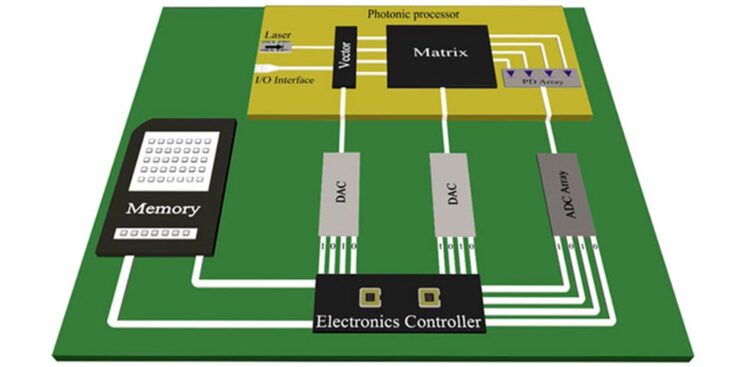Matrix multiplications at the speed of light

Electro-optic blocks cointegrated for the development of a neuromorphic photonic processor.
Credit
Giamougiannis et al., doi 10.1117/1.AP.5.1.016004
Compact silicon photonic computing engine computes tiled matrix multiplication at a record-high 50 GHz clock frequency.
“All things are numbers,” avowed Pythagoras. Today, 25 centuries later, algebra and mathematics are everywhere in our lives, whether we see them or not. The Cambrian-like explosion of artificial intelligence (AI) brought numbers even closer to us all, since technological evolution allows for parallel processing of a vast amounts of operations.
Progressively, operations between scalars (numbers) were parallelized into operations between vectors and, subsequently, matrices. Multiplication between matrices now trends as the most time- and energy- demanding operation of contemporary AI computational systems. A technique called “tiled matrix multiplication” (TMM) helps to speed computation by decomposing matrix operations into smaller tiles to be computed by the same system in consecutive time slots. But modern electronic AI engines, employing transistors, are approaching their intrinsic limits and can hardly compute at clock-frequencies higher than ~2 GHz.
The compelling credentials of light — ultrahigh speeds and significant energy and footprint savings — offer a solution. Recently a team of photonic researchers of the WinPhos Research group, led by Prof. Nikos Pleros, from the Aristotle University of Thessaloniki, harnessed the power of light to develop a compact silicon photonic compute engine capable of computing TMMs at a record-high 50 GHz clock frequency. As reported in Advanced Photonics, they employ silicon-germanium electro-absorption modulators and a novel neuromorphic architectural design capable of encoding and computing data. According to corresponding author George Giamougiannis, “This work paves the way for the resolution of DL‑based applications that require line-rate computations,” and the work promises to contribute significantly to data center cybersecurity.
Data center cybersecurity: Light hunting the evil
Undoubtedly, the AI burst has equipped both benign and wicked users with strong toolkits to speed-up and automate their activities. With the data travelling in the data centers (DCs) augmenting by ~13 percent year‑by‑year, they have become a major target for malicious individuals who aim to compromise sensitive data, e.g., financial data, personal information, and intellectual property of many organizations, including government agencies, military forces, hospitals, and financial institutions. On that account, DC cybersecurity is imperative to prevent invaders accessing classified information.
Indeed, threat detection mechanisms face a new set of requirements resulting from the quantity of data flowing through the vast number of servers and switches within contemporary DCs. Real-time threat detection is imperative: packet inspection must be processed at ultrahigh speeds. Moreover, threats must be detected as early as possible within the route of the malicious packets: every DC node should be equipped with a powerful cybersecurity toolkit.
Exploiting their ultrafast processor, the researchers from Aristotle University of Thessaloniki, in collaboration with NVIDIA’s experts in the field of DC cybersecurity, successfully merged silicon photonics with AI to establish a framework to identify successfully and swiftly one of the most common types of DC attacks, namely distributed denial‑of‑service (DDoS) attacks, in NVIDIA’s servers at line‑rates. Thanks to this novel computational scheme, the number may soon be up for DC attacks – at least for the time being.
Read the Gold Open Access article by Giamougiannis et al., “Neuromorphic silicon photonics with 50 GHz tiled matrix multiplication for deep learning applications,” Adv. Photon. 5(1) 016004 (2023), doi 10.1117/1.AP.5.1.016004
Journal: Advanced Photonics
DOI: 10.1117/1.AP.5.1.016004
Method of Research: Experimental study
Subject of Research: Not applicable
Article Title: Matrix multiplications at the speed of light
Article Publication Date: 1-Feb-2023
Media Contact
Karen Thomas
SPIE–International Society for Optics and Photonics
karent@spie.org
Office: 360-685-5492
All latest news from the category: Information Technology
Here you can find a summary of innovations in the fields of information and data processing and up-to-date developments on IT equipment and hardware.
This area covers topics such as IT services, IT architectures, IT management and telecommunications.
Newest articles

NASA: Mystery of life’s handedness deepens
The mystery of why life uses molecules with specific orientations has deepened with a NASA-funded discovery that RNA — a key molecule thought to have potentially held the instructions for…

What are the effects of historic lithium mining on water quality?
Study reveals low levels of common contaminants but high levels of other elements in waters associated with an abandoned lithium mine. Lithium ore and mining waste from a historic lithium…

Quantum-inspired design boosts efficiency of heat-to-electricity conversion
Rice engineers take unconventional route to improving thermophotovoltaic systems. Researchers at Rice University have found a new way to improve a key element of thermophotovoltaic (TPV) systems, which convert heat…



